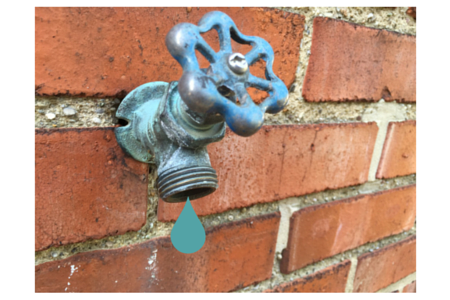Water your commercial property’s turf and plants too often, and you’re wasteful. Don’t water them enough, and you’ll be left with a brown eyesore of a landscape.
Luckily, there’s a happy compromise between running a water park and watching tumbleweeds blow by: Xeriscaping.
No, it’s not some strange, trendy landscape exercise. It’s a method that will make your landscape more efficient and sustainable.
The basic definition of xeriscaping is landscaping that reduces the need for supplemental water from irrigation. Sounds good in theory, but what does that mean in practical terms for your commercial property?
What Is Xeriscaping, Exactly?
Xeriscaping practices are nothing new, but they are becoming more widespread with all of the local water restrictions and increasing drought seasons throughout parts of Texas.
This type of landscaping is about introducing and using indigenous plant materials that will keep the water use low on properties.
In addition to lowering water usage, xeriscaping is also about having a landscape with minimal maintenance.
So, instead of having large areas of turf around your buildings or stores, you can incorporate plants that require little water and maintenance. Xeriscaping costs less to maintain than a standard landscaping of the same square footage that consists of turf, shrubs, and groundcovers, as well.
It’s something we’ve seen clients in Central and South Texas want for the past 15 to 20 years. The sustainable trend is especially popular in Austin, San Antonio, and the valley — and less so in Houston and Dallas.
Just don’t get xeriscaping confused with zeroscaping, which is a landscape with no plants and just rocks.
Benefits Of Xeriscaping On Your Property
 Beyond protecting the environment and natural resources, there are even more things you (and your budget) can enjoy about incorporating xeriscaping ideas.
Beyond protecting the environment and natural resources, there are even more things you (and your budget) can enjoy about incorporating xeriscaping ideas.
Check out just a few of the benefits of xeriscaping:
- Conserves water
- Lowers utility bills
- Requires less maintenance — resulting in lower cost for maintenance services
These benefits will increase over time as your xeriscape plants and design become more established.
How To Xeriscape Texas — Common Xeriscaping Design Ideas
Some of the most popular ways to have a xeriscape landscape include reducing your amount of turf space, installing drought-tolerant plants, and adding more shade elements to reduce the amount of water needed.
You can also make your commercial landscape more sustainable with mulches, an updated irrigation system and using organic materials when possible.
The xeriscape idea is all about helping your landscape thrive without much outside help, like supplemental water or maintenance.
Pro Tip: Where To Incorporate Xeriscaping On A Commercial Property
Xeriscaping can work on pretty much any area of your landscape, but there are certain spots that will be more efficient than others.
Some prime real estate for xeriscaping includes low-traffic areas, plant beds, around water features, surrounding patios or large turf areas.
Avoid xeriscaping near walkways or streets since these areas need more maintenance to avoid overgrown plants that could block traffic.
10 Popular Texas Xeriscape Plants

Just because you’re cutting down on your water usage and maintenance doesn’t mean you can’t still have plants with real wow factors.
Choose native or adaptable plants that fit your landscape’s conditions and style. Here are 10 popular plants used in xeriscaping:
- Bat-Faced Cuphea: Its red and purple flowers resemble the winged animal this plant gets its name from. It needs full to part sun and is heat tolerant. Bat-Faced Cuphea grows about 1 foot tall and wide.
- Black-Eyed Susan: This perennial has large, yellow blooms and does well in Central Texas to Houston. It needs to be cut back during the winter and has a height and spread of 1 to 2 feet.
- Desert Willow: It grows quickly and has flowers spring through summer. This plant grows 15 to 25 feet tall with a 15- to 25-foot spread. The desert willow does best in full-sun areas.
- Gulf Muhly: This ornamental grass has pink, feathery seed heads during the fall that add color. They can reach 2 to 2 1/2 feet high with a 2- to 3-foot spread.
- Purple Heart: With purple leaves and small, dark pink flowers, this plant will die back during the winter and return in spring. It’s ideal for low-maintenance areas like rock gardens and mixed borders. Purple Heart can grow 12 to 18 inches in height and spread.
- Red Yucca: It will bring a pop of color to your landscape and grows 6 feet high with a 4-foot spread. They aren’t suited for pedestrian spaces, however.
- Sedum: There are several different types of sedum, including ones that work well with rock gardens. They can range in height from just 2 inches to more than 2 feet — making the smaller varieties a good groundcover option.
- Texas Sage: This shrub provides plenty of purple flowers throughout the year, and it has a height and spread of 4 to 5 feet. It’s best for Central Texas, although it can be used in Houston, as well.
- Texas Redbud: This tree can grow 10 to 20 tall and blooms white (rarest of the colors), pink or purple.
- Trailing Lantana: Good for all regions of Texas, it blooms summer to fall with orange and yellow flowers. It reaches 3 to 5 feet high with a 4- to 6-foot spread.
Pair native and adaptive plants with other low-maintenance varieties so you can water and maintain them at the same intervals.
Partner With A Texas Landscaping Company That Knows Xeriscaping
Now that you know what it is and how to incorporate this sustainable practice into your landscape, look for a commercial company that uses xeriscape landscaping practices daily.
At Yellowstone Landscape, we follow xeriscaping practices as a default, unless a client dictates otherwise. It comes as second nature to us since it’s part of our daily routines. Plus, we know what plants work best to make Texas landscapes sustainable because we’ve used a wide variety.
That dedication to sustainability extends from the materials we use to our irrigation management techniques.
Ready to save water and money on your property with xeriscaping? Contact us.
Images: Bat-faced cuphea, Sedum, Texas sage, Trailing lantana



